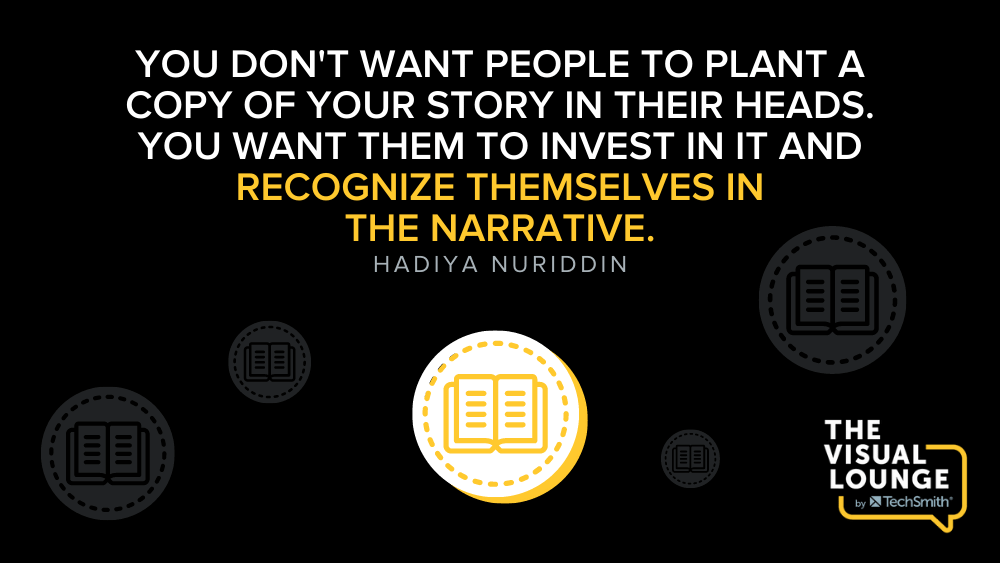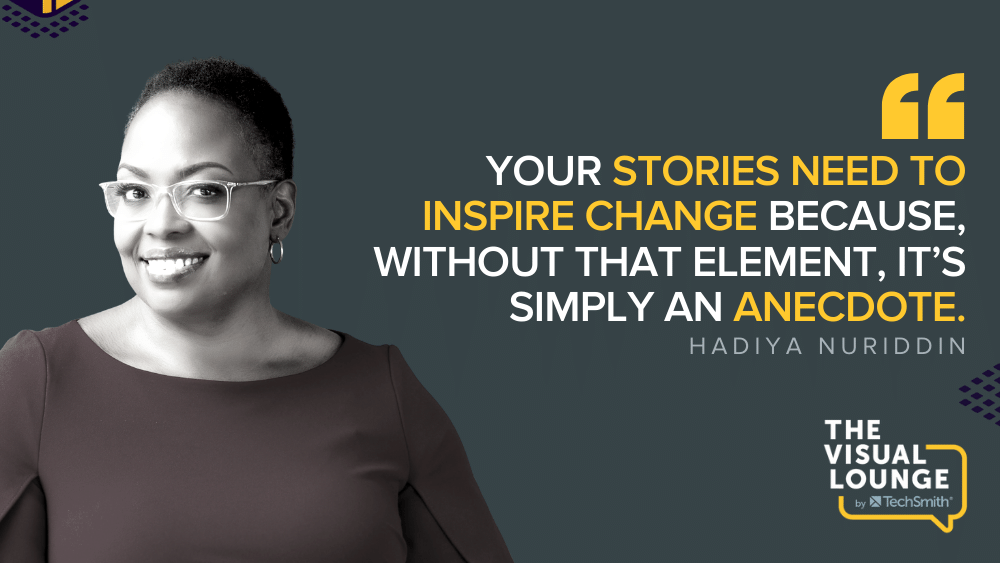Storytelling can be a powerful tool in the L&D community.
But, as it is with most tools, you need to know how to use it to get the desired end result. That’s what Hadiya Nuriddin, Learning Strategist, speaker, and CEO of Duets Learning explores on this episode of The Visual Lounge.
Hadiya doesn’t just have a wealth of experience developing and delivering both technical and professional development courses, she’s an advocate for storytelling. She believes that the right stories can deliver context, spur empathy, and inspire people to take “expected” actions.
As Hadiya explains, there’s always a story. It’s up to us to figure out how and when to use it.
Listen to this episode of The Visual Lounge to learn how to leverage the power of storytelling for everything from compliance training to customer service training.
You can watch the video on this topic at the top of this post, to listen to the podcast episode, hit play below, or read on for more…
When to use storytelling?
For starters, storytelling is simply a tool. It’s just one of the many ways we convey information in order to inspire a particular action.
So, knowing when to leverage this tool depends on your intent. One of the best ways to reveal your intent is to ask yourself these questions:
- What do you want people to do with the information?
- What do you want them to feel or believe?
- How do you want them to act afterward?
Once your intent is clear to you, you can use it to build your story and give your audience the right context.
If you’re in L&D, you already know there are topics that everyone can relate to and others that tend to alienate people. But with the right context, you can connect those dots and fill those gaps to deliver a narrative that a general audience can relate to.
This more focused approach to storytelling and being intentional could be the very thing to spark the performance you’re looking for.
The relationship between storytelling and emotions

If you ask a group of people what makes storytelling so compelling, most of them will say it’s all about the emotions they trigger.
Hadiya points out that people respond to having their emotions triggered in different ways. So, you have to find out the particular emotions that’ll drive your desired outcome.
One way to approach this is to make them feel that something is at stake for them personally – because risk or loss are universal fears.
Of course, you can’t make people act or learn, but it’s possible to create circumstances where they’ll be more likely to take action.
Layers of storytelling
It’s true that you can find a story in any situation.
But stories don’t form at random, you have to put some thought into them.
Some people have cracked the code and can spin a story on the spot. But, if you’re just getting started, there are two layers to storytelling you can use as a guide:
1. The academic aspect
It all starts with an intense understanding of the narrative structure. With elements like climax, conflict, and resolution, it’s easier to give your story more substance. You can learn how to weave these elements into your stories by reading books or using your observation skills.
2. Vulnerability
If there’s one thing that audiences can relate to, it’s vulnerability because that’s where their pain points lie.
More often than not, the things that motivate you to take action are the same things that motivate others.
But here’s the thing, showing your authentic self practically creates a variant of the story that’s no longer yours. Based on that, Hadiya advises people to withhold stories that’ll end up compromising their psychological safety.
If you choose to share a personal story, remember that your audience isn’t just listening. They’re also filtering your words through their own experiences. Because of that, they may not come to the same conclusion as you.
However, with a compelling story, there’s a good chance that they’ll find something to relate to in your narrative, and that’s ultimately what you should aim for.
Is it necessary to use stories in learning and development?

Some messages can definitely be delivered without a story. But, as Hadiya says,
“There’s always a story, the question is if you can find it.”
But whether that story is necessary is a whole other ball game. You need to ask yourself whether people will be able to easily create their own context to understand your message.
Is the topic too foreign, or are there too many barriers to understanding?
If the answer to either of those questions is yes, then it’s time to try turning your message into a story.
However, if you think the audience is unlikely to remain patient enough to digest the story, then it’s advisable to skip it altogether. There’s no harm in trying out either method and seeing the results.
For more pointers on how to use storytelling to get your message across, head over to the TechSmith Academy.



Share